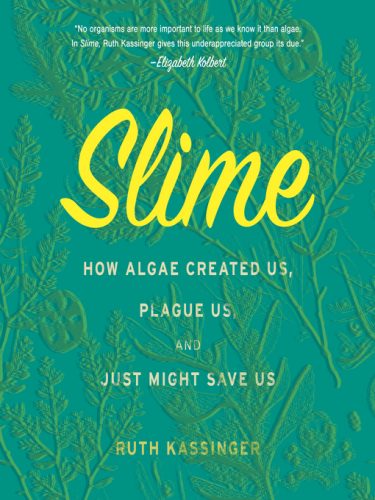How much do you think about algae? Unless you regularly eat seaweed snacks, likely not much. However, algae—albeit green and slimy—is more than meets the eye, and this tiny organism might even have an important role in shaping our future. Author Ruth Kassinger set out to illuminate the underappreciated capabilities of algae. Her new book, SLIME: How Algae Created Us, Plague Us, and Just Might Save Us, uncovers the potential behind algal technologies and discusses algae’s uses in contemporary society.
Kassinger first investigates the nutritional benefits of algae. Algae is most commonly consumed as seaweed, such as Porphyra—otherwise known as Nori—which is predominant in East Asian cuisine. Algae is a great source of iodine, which we use to moderate thyroid hormones, and docosahexaenoic acid (DHA), which is vital to brain growth and development. Not limiting algae to just human consumption, Kassinger writes about microalgae as food for fish in aquacultures. This method allows aquacultured fish to receive their required nutritional intake, unlike the fish who are fed fishmeal and soybeans. Check out the nutritious seaweed recipes compiled at the end if you want in on the nutrition!
Kassinger also highlights the possibility of algae-produced fuel—a subject of immense bioengineering research. The current algae fuel product has limitations, but methods to decrease cost and increase productivity are advancing. The main challenge is productivity, which currently drives up the price. “Algae oil and plastics have already been made,” Kassinger said. The US Navy has run ships and planes on algae oil; UPS ran some of its trucks on algae gasoline. A Mississippi company makes algae shoes. The problem isn’t technology, but cost.” A large-scale transition to algae fuel would be an enormous investment, but it would be a monumental step towards green energy production and climate change mitigation.
Kassinger further delves into a fascinating exploration of marine ecosystems, where human-caused algal blooms result in toxic dead zones. While harmful, these blooms may have some unexpected benefits. Kassinger shows how the field of geoengineering is making strides toward a fuller understanding of how algae function as carbon sinks—a role they’ve been playing for billions of years. Kassinger writes about algae’s role 2.5 billion years ago in cooling the earth as they soaked up greenhouse gases, which shows that algae have greatly decreased the amount of atmospheric carbon dioxide in the past. Recognizing this, scientists are further researching the intricacies behind algae’s carbon capture potential.
“Algae are amazing engines of stuff, and there’s almost unlimited possibilities of creating useful or nutritious products with algae” Kassinger said. Ultimately, Slime reveals both the scandalous myths and hidden capabilities of an otherwise overlooked snack food.

